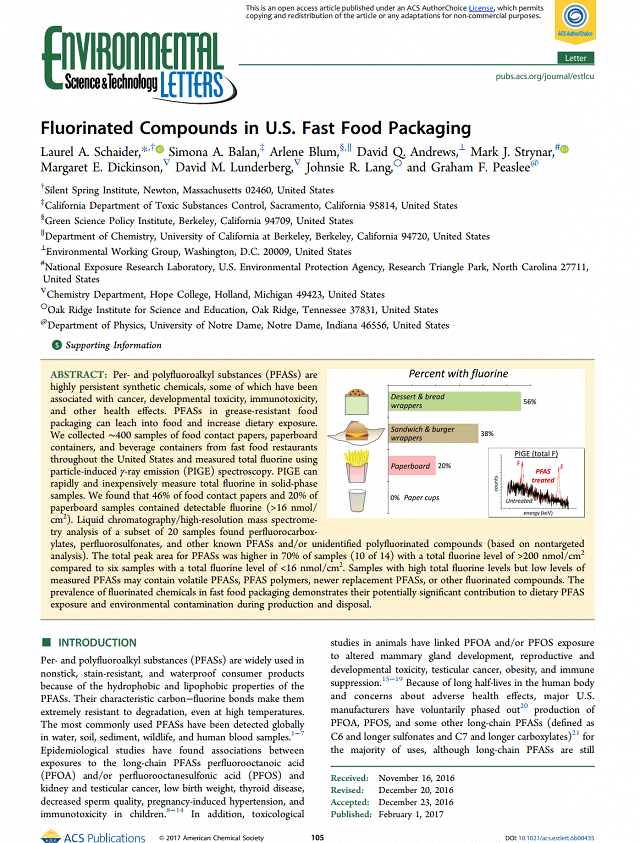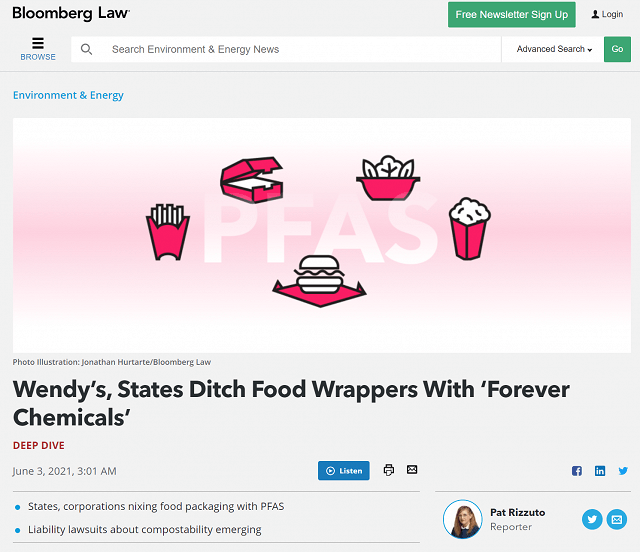Case Study: PFAS in Food Packaging
Research + Partners + Communications = Change
 Research:
Research:
Our Institute collaborated with the University of Notre Dame, the Environmental Protection Agency, Silent Spring Institute, and Environmental Working Group to collect and screen fast food packaging for fluorine—indicating the likely presence of PFAS in 2017. In 400 samples of take-out packaging from fast food restaurants across the U.S., we published a paper in the peer-reviewed journal Environmental Science and Technology Letters finding that 46% of food contact papers and 20% of paperboard contained fluorine. Previous research has shown such chemicals can migrate from packaging into the food that people eat.
Partners:
- Environmental Working Group prepared a campaign for consumers to ask the Food and Drug Administration to ban PFAS in food contact materials. The campaign was launched the day the paper was published.
- Senator Richard Blumenthal wrote the CEOs of major fast food chains questioning their use of PFAS and encouraging them to move to safer alternatives.
Communications:
- We wrote an engaging press release and pitched to reporters under embargo starting one week before the publication date.
- A week after the paper was published, we held a workshop with the food packaging industry, scientists, government, representatives of the supply chain, and innovators. Together they started developing plans for healthier food packaging. According to Allen King, a food packaging executive who attended the workshop, “It was an ‘aha’ moment that led us to commit to finding ways to cease using PFAS and find alternatives.”
 Results:
Results:
- The study was covered widely by the media, including CNN, Huffington Post, the Verge, Bloomberg, and more. As a result, the study achieved a high Altmetric score and has had about 40,000 downloads. It currently has the fourth-highest Altmetric score for any paper ever published by the journal.
- Shortly after the paper was published, California State Assemblymember Phil Ting introduced Assembly Bill 958, which would have been the first in the nation to ban the whole class of PFAS in fast food packaging and takeout containers.
- Washington, Vermont, New York, Maine, and Minnesota have passed bans on PFAS in food packaging. Many more states have bans under consideration.
- The City of San Francisco banned PFAS in single-use foodware. Other cities and counties have followed suit.
- Restaurant and grocery chains that collectively represent nearly 80,000 stores, including Chipotle, Wendy’s, Whole Foods Market, and McDonald’s, have removed or committed to limiting PFAS in their products. Food packaging companies have begun to do the same.
- Denmark became the first country to ban PFAS in paperboard food packaging in 2019.
- In 2020 Congress banned PFAS in military Meals Ready to Eat packaging.
- Rep. Debbie Dingell has reintroduced the Keep Food Containers Safe from PFAS Act, which would empower the FDA to deem PFAS in any food containers or cookware as unsafe.
- A fast food restaurant industry representative told us that as soon as our paper was published and publicized, the industry realized they would need to stop using PFAS and began looking for effective and affordable alternatives.
- In October of 2021, California enacted AB 1200 banning the use of PFAS in food packaging, and requiring cookware manufacturers to disclose the hazardous chemicals, including PFAS, used in their products.